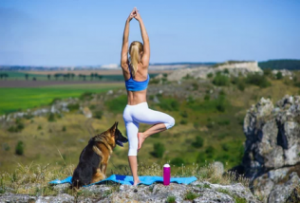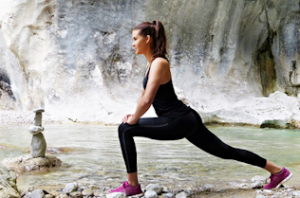Active Isolated Stretching, also known by its short-form AIS, is a type of stretching routine that was developed by a man named Aaron Mattes. Although it was created over forty years ago, it is probably even more popular now, as many more people see the benefits of the routine.
To be honest, it is not a case of popularity, but rather, the realization that stretching should be done safely and by everyone, not just by sports-minded individuals.
Increasingly, over time, the techniques have become standard for plenty of athletes, both professional and amateur. Physical therapy courses are built around the regimen, and lots of people have suggested that their heath care personnel recommended these types of stretches.
Just to make things clear, there is no mystery involved in what this program does. Basically, the concept focuses on lengthening the muscles or tendons, by holding stretches for a few seconds, and completing several repetitions.
 Think about when you are finished a workout session or an aerobics class…
Think about when you are finished a workout session or an aerobics class…
The instructor usually has you wind down with a few stretching exercises, such as holding your arm at the elbow across your chest.
That pose has the end result of stretching out your arm and shoulder muscles.
Typically, AIS falls into the dynamic type of stretching which subscribes to the method of holding for a very short time, thus only a quick two seconds. The key is to do this more than once to achieve maximum benefit. That is called repetitions.
It is believed, and has been proven, that active isolated stretching is a much safer way of stretching, as you are not forcing your muscles.
Plus, instead of being really sore afterward, you should actually feel better and quite rejuvenated once the stretches are completed.
Stretches are not supposed to be painful. They should be restorative.
Active Isolated Stretching Benefits
Health and wellness are the key functions of any physical activity. Whatever exercise you prefer, it should provide serious benefits for your mind, body and soul. It should be curative, and restore all elements of you to a natural harmonious state.
Let’s look at the twelve ways active isolated stretching benefits your body, your mind, your health, and your overall well-being.
#1 Body Repairs Itself
Stretching helps the body repair areas that need attention. They may have been damaged or overused due to a repetitive job, previous injury, a new injury, or just plain hard work around the house or garden.
By stretching out those sore muscles, you oxygenate them releasing toxins and injecting them with fresh life.
#2 Prepares Body for Daily Activity
Even if you aren’t an athlete or are not training for some event, it is still important for everyone to do exercises. Remember that your daily tasks take a heavy toll on the body as they can be strenuous and repetitive.
Active Isolated Stretching can help you get ready for your day ahead by doing a few quick and safe stretches. You can do them when you get up before your have your shower, or wait until you finish eating breakfast, and devote the ten or fifteen minutes to your routine.
You’ll feel much more eager to get your chores done, plus your body will be ready for whatever lies ahead.
#3 Increases Blood Circulation
Stretching your muscles gets things moving inside. Have you ever noticed that when you sit too long, your ankles swell up?
The blood is pooling and is not circulating properly. That’s why the experts tell you to try and stand up when on a long airplane flight. They might even recommend compression stockings to get the blood moving back to the heart.
By completing some simple stretches you can improve your blood circulation which in turn removes the added work for your heart.
#4 Can Be Good Cardio
Often times, you’ll also want an exercise that increases your heart rate. This is normally called cardio.
Most people think that stretches are too docile, and thus, do not help from a cardiovascular fitness standpoint. But they would be wrong because a proper stretching routine will help to encourage the heart to pump stronger and healthier, as well add needed oxygen to the system.
#5 Body is More Flexible and Agile
Not everyone wants to be a cheerleader and do the splits. But everyone can benefit from added flexibility in their movements.
You know the feeling when you reach up into the cupboard to get something at the back or higher up? Your side and arm pull, right?
It is not a comfortable feeling, but with regular active isolated stretching, you’ll find yourself more able to do everyday tasks without feeling the strain. Plus, you’ll feel your childhood agility coming back again.
#6 Prevents Injury
Because stretching prepares your body for future activities, it actually helps to prevent serious injuries. Since your muscles and tendons are more conducive to the activity, there is less chance of tear or excessive strain on the muscle.
#7 Better Posture
Nice stretching of the spine, upper and lower back, as well the neck will give you straighter posture. When you slouch, it actually causes cricks in the neck, which can be quite painful.
Stretching keeps the pains away, and if you already have troublesome aches, stretching will help to get rid of them.
#8 Reduce Stress
We are all under a lot of pressure. Whether it is a demanding or miserable job, over-burdened with debt, medical issues, familial problems, or too much to accomplish in a day, stress is everywhere and affects billions of people.
And, while it may sound trite to offer stretching as a means to help you reduce your stress levels, active isolated stretching does just that.
Of course, your problems won’t go away. But, the endorphins that are released by maintaining a regular routine of exercises do free up some of the mental load.
#9 Improves Strength
The truth is that stretching, when done properly and consistently, helps your body to stay strong. It not only improves your strength, but also allows some muscles to develop strength.
We tend not to use all our muscles, but if we focus on a well-rounded plan of stretches, we can incorporate stretches that target all areas of the body.
#10 Quick Relief for Pain
Stretching is a quick way to relieve stiffness all over the body. Whether you slept in the wrong position and your neck aches, or you have a headache from a sore back, stretching can really soothe the pain.
#11 Reduces Water Retention
You know the feeling when your hands are so swollen, you can’t remove your rings? Or when you are bloated to the point you can get your pants done up?
That can be from edema or fluid retention. For whatever reason, the body doesn’t expel the excess liquid.
Instead of buying costly remedies, it is often enough to start a physical activity program. Stretching is the perfect answer.
#12 Eliminate Metabolic Waste
This is just a fancy way of saying your body needs to get rid of excess toxins. Our bodies retain all kinds of bad stuff we don’t use.
For example, it may not expel the extra salt it doesn’t need or it may hold on to nitrates from processed foods. Regardless of how or why the toxins stayed in the body, stretching is definitely a way to push them out.
Active Isolated Stretching Advantages
- Not painful to do. If stretching causes pain, then it is not being done properly or probably comes from the static form of stretching. It’s important to understand the difference between active isolated stretching vs static stretching.
- It is a progression. In other words, you use a regular consistent movement to increase range of motion without causing tears and sprains. You don’t bounce around while stretching, nor do you force muscles into unhealthy lengths.
- Prevents the cycle of contracting and expanding muscles, which causes pains and cramps. By keeping your muscles and tendons limber, they are ready for anything, and do not need coaxing.
- AIS can be done in smaller blocks of time a few times per day at home, instead of having to spend hours traveling to, and working out at the gym.
- Stretches are free if you do them at home or at the park by yourself or with a friend.
- Stretching targets different problems as you can see from the benefits listed above.
- If you don’t like vigorous workout programs, then you can still get plenty of benefits from stretching, plus it gets you physically moving, which is much better than inactivity.
Active Isolated Stretching Meaning
AIS is a simple routine that anyone can follow, but it is incredibly good for your health and physical well-being.
There are only four steps that you need to know:
- You isolate the muscle that you want to work on or stretch out.
- You stretch the muscle for two seconds.
- You complete ten repetitions.
- Remember to breathe by inhaling on the stretch, and exhaling when you release the stretch.
Now let’s look at that in a bit more detail.
Not everyone understands the mechanism of the body’s muscles, but basically, you stretch one muscle by relaxing it while the opposite muscle contracts.
So for example, if you target active isolated stretching for hamstrings, then flex or contract your quadriceps. If you are focusing on how to stretch tight quadriceps, then you flex your hamstrings.
Likewise, hip flexors and gluteus maximus are the opposites.
When speaking about holding for two seconds, there is no more benefit to holding longer. In fact, it is disadvantageous, and is actually what you are trying to avoid when doing AIS.
The repetitions are required because they allow the increase of blood circulation, as well as the fresh oxygen and nutrients to reach the muscles being stretched.
Lastly, the systematic breathing aids with oxygen generation and circulation of blood.
Active Isolated Stretching vs Static Stretching
We’ve mentioned that AIS is dynamic stretching and that it is different than other types of stretches. Specifically, the other type of stretching is called static stretching.
You’ve probably heard the two expressions:
- ”No pain, no gain.”
- ”You need to feel the burn.”
These sayings are usually associated with static stretching because it requires holding the stretch for a long period of time. It forces the muscles or tendons to grow longer.
The problem with that sort of thinking and consequently completing exercises like that is that they can be damaging. You may be stretching the muscles beyond their natural limits resulting in them becoming weaker or looser than normal.
This in turns causes them to perform poorly and can even lead to injury as you don’t expect them to let you down.
The muscle can’t work at optimal capacity because it has been damaged with the stretch. Then, when you try to run or lift weights, or whatever strenuous activity you plan on doing, you don’t have the proper support you need to complete the task.
Active Isolated Stretching Examples
These are eight names of some of the stretches that are involved with AIS stretching.
- Quadriceps Stretch
- Single Leg Pelvic Tilt
- Lateral Trunk Flexors
- Hip Adductor Stretch
- Gastrocnemius
- Trunk Extensions
- Straight Leg Hamstring Stretch
- Bent Leg Hamstring Stretch
Final Thoughts on Active Isolate Stretching
By now, you probably have a clearer understanding of what active isolated stretching is and how it can benefit you.
To help soothe your mind, body and soul, why not get started on a few stretches today? You don’t have to do many, but get yourself going, and move up from there!



